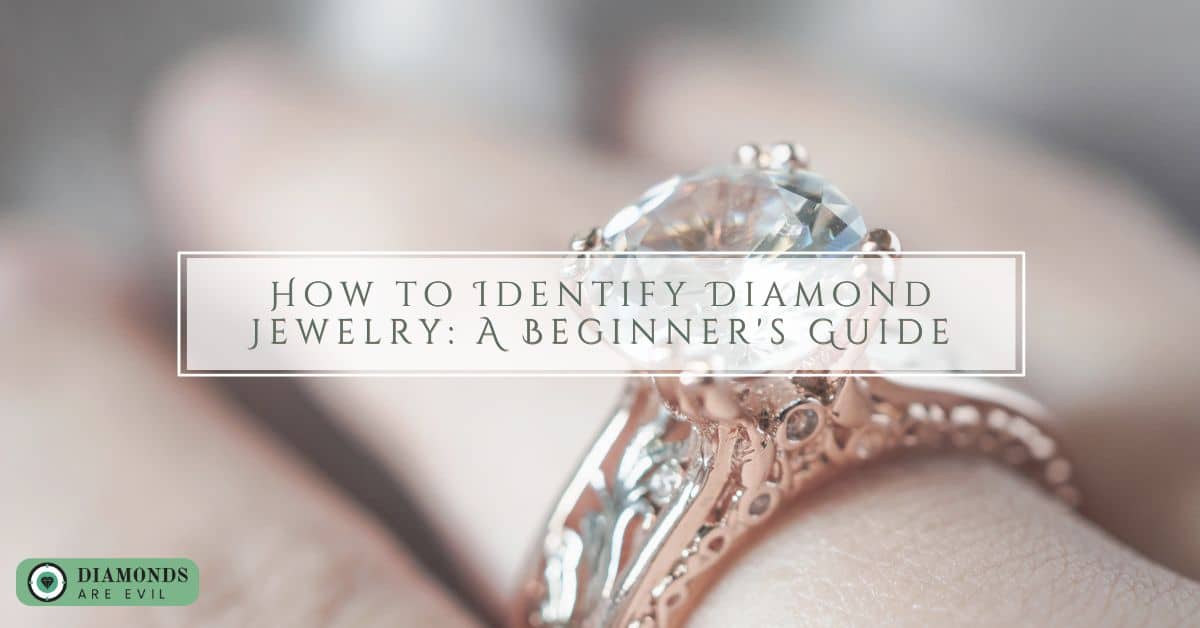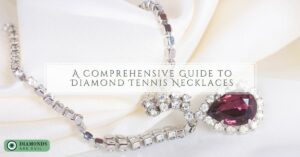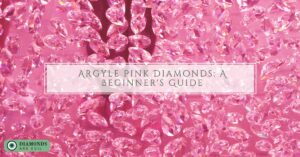Identifying diamond jewelry requires attention to the “four Cs”: carat weight, cut, color, and clarity. Inspect the jewelry under good lighting, use a loupe for closer examination, and try a diamond tester to verify authenticity. It’s also helpful to get a professional appraisal or certification for valuable pieces.
In this guide, we’ll cover the basics of what makes a diamond valuable, how to identify different types of diamond jewelry, and what to look for when purchasing diamonds. Whether you’re looking to buy a diamond engagement ring, a necklace, or a pair of earrings, this guide will give you the knowledge you need to make an informed decision. So, let’s get started!

Importance of Diamond Jewelry
Diamond jewelry has always been a symbol of elegance and luxury across cultures. The significance of diamonds goes beyond just being a precious gemstone. They are a representation of commitment, love, and timeless beauty. Diamond jewelry has evolved from being a simple ornament to a statement piece that holds deep emotional value.
Diamonds are one of the hardest materials found on earth, which is why they are used extensively in jewelry. The brilliance and sparkle of diamonds are unmatched, making them an impeccable addition to any attire.
The importance of diamond jewelry lies in the fact that it can be passed down from generation to generation, symbolizing everlasting love and loyalty. It is undoubtedly an investment that is worth the price, and its value lasts a lifetime.

Understanding the 4 C’s
When it comes to diamonds, you’ve probably heard of the 4 C’s (carat weight, color, clarity and cut), but do you really understand what they mean and why they matter? Whether you’re in the market for an engagement ring or simply have a fascination with the world’s hardest natural material, it’s important to understand the 4 C’s in order to make informed decisions.
As you dive into the world of diamond education, you’ll discover that each of these four factors plays a crucial role in determining a diamond’s value and beauty. So, let’s break it down and get a better understanding of the 4 C’s.
Carat Weight
When it comes to buying a diamond, one of the most important factors to consider is its carat weight. Carat weight refers to the size and weight of the diamond, and is one of the four C’s that jewelers use to assess a diamond’s quality. While carat weight is often thought to solely determine a diamond’s value, it’s important to remember that the other three C’s – cut, color, and clarity – also play a significant role.
Understanding the four C’s can help you make an informed decision when purchasing a diamond, ensuring that you get the most value for your investment. So, whether you’re shopping for a diamond engagement ring, pendant, or earrings, don’t forget to consider the carat weight – just be sure to consider the other three C’s as well.

Color
Diamonds are undoubtedly one of the most precious and sought-after gemstones in the world. Color is often misunderstood or overlooked, but it’s equally important in bringing out the beauty and brilliance of a diamond. The color grading scale ranges from D (colorless) to Z (light yellow or brown), with each grade having a significant impact on the diamond’s overall value and appearance.

Clarity
Clarity is a crucial aspect when it comes to the quality of diamonds. It refers to the absence of any blemish or inclusion, which can obstruct the passage of light and affect the diamond’s brilliance. A diamond’s clarity is evaluated under a tenfold magnification scale, with flawless diamonds being considered the best quality.
While natural diamonds are never entirely flawless, many are close to being so. Alternatively, some diamonds may have inclusions that are visible to the naked eye, reducing their value. The clarity of a diamond can significantly affect its price, making it an essential factor to consider when buying or selling diamonds.

Cut
As one of the most recognizable and treasured gemstones in the world, diamonds have been coveted for centuries. And within this world of precious stones, there is perhaps no more important characteristic than the cut of a diamond. Cut refers to the angles and proportions of a diamond’s facets, affecting its overall brilliance, fire, and scintillation.
The cut of a diamond can greatly impact its value, and requires expert skill and precision to achieve the optimal balance of beauty and value. Whether searching for the perfect engagement ring, or simply seeking a stunning piece of jewelry, understanding the importance of cut is essential to making an informed and worthwhile purchase.

The Importance of Certification
When it comes to diamonds, there are many factors to consider. One of the most important factors is certification. A certification provides assurance and peace of mind that the diamond is of high quality and has been ethically sourced. Without a certification, it can be difficult to determine the true value of a diamond, which can lead to overpaying or purchasing an inferior product.
Additionally, certified diamonds can often be insured for a higher value than uncertified ones. So, whether you’re investing in a diamond for an engagement ring or simply adding to your jewelry collection, it’s always a good idea to choose certified diamonds.
Types of Certification
Diamonds are among the most precious and sought-after gems in the world, and as such, their value is often determined by various factors, including the quality of the stone, its cut, carat weight, and color.
However, to ensure that diamonds meet certain standards and are genuine, they often undergo certification by independent, third-party organizations. Diamond certification provides buyers with assurance of the diamond’s quality and authenticity.
There are several types of certification available for diamonds, each with its own set of standards and requirements. In this response, we will discuss some of the most common types of certification in diamonds.

GIA Certification: The Gemological Institute of America (GIA) is a leading diamond grading organization that provides diamond certification based on the 4Cs – carat weight, cut, color, and clarity. GIA certification is considered the industry standard, and diamonds certified by GIA are often the most valued.
AGS Certification: The American Gem Society (AGS) is another well-known diamond grading organization that provides certification based on the 4Cs. However, AGS places a greater emphasis on the cut of the diamond and its overall quality.
EGL Certification: The European Gemological Laboratory (EGL) is a diamond grading organization that provides certification based on the 4Cs, but it is known for being more lenient in its grading standards than other organizations like GIA and AGS.
IGI Certification: The International Gemological Institute (IGI) is a diamond grading organization that provides certification based on the 4Cs. IGI is known for its focus on color grading and is often preferred by buyers looking for colored diamonds.
HRD Certification: The Hoge Raad voor Diamant (HRD) is a Belgian diamond grading organization that provides certification based on the 4Cs. HRD is known for its strict grading standards and is often used by European buyers.
How to Spot a Fake Diamond
Diamonds are a symbol of luxury, love, and commitment. But how do you distinguish a real diamond from a fake one? A fake diamond can be a disappointing and costly mistake. A genuine diamond is an investment and worth every penny.
Although it requires some knowledge, identifying a fake diamond is not that challenging. Educating yourself on the characteristics of genuine diamonds can help you spot a fake one instantly. Here are some tests to know on how to spot a fake diamond:

Step 1: Basic Tests
When it comes to purchasing a diamond, knowing how to spot a fake one can save you from making a costly mistake. Basic tests can help you determine whether a diamond is real or fake. The first step is to examine the diamond closely, looking for any visible imperfections or inclusions.
The Fog Test
When it comes to purchasing diamonds, it’s important to know exactly what you’re getting. After all, diamonds are a significant investment, both financially and emotionally. That’s where the fog test comes in.
This simple yet effective test is one of the basic methods to spot a fake diamond. To perform the fog test, simply hold the diamond or diamond jewelry up to your mouth and breathe on it, just like you would a mirror.
If the diamond stays fogged up for a few seconds before clearing, it’s likely a fake. Genuine diamonds disperse heat quickly and won’t fog up easily. While the fog test isn’t foolproof and shouldn’t be used as the sole means of determining a diamond’s authenticity, it’s an easy and accessible method to add to your arsenal.

The Water Test
Diamonds have long been a symbol of luxury and status, making them a sought-after choice for jewelry. However, not all diamonds are created equal, and some may not even be genuine. The water test is a basic yet effective way to spot a fake diamond.
Simply fill a glass with water and drop the diamond in. If it sinks to the bottom, it’s likely a real diamond. If it floats or stays suspended in the water, it’s likely a fake. This test works because diamonds are denser than water, which means they will sink.

The Sandpaper Test
The Sandpaper Test is one of the basic tests used to identify a fake diamond. This test involves scratching the suspected diamond with sandpaper, which will leave a visible scratch mark if the diamond is fake. A real diamond is one of the hardest materials on Earth and cannot be easily scratched by anything other than another diamond.
This test is a quick and easy way to spot obvious fakes, although it is not foolproof and should be used in combination with other tests for a more accurate evaluation. Professional jewelers and diamond experts use a variety of techniques and instruments to detect fake diamonds, and if you are looking to buy a diamond, it is important to choose a reputable seller and ask for a certificate of authenticity to ensure you are getting a real diamond.

Step 2: Professional Tests
When it comes to buying diamonds, the last thing anyone wants to do is to end up with a fake. The good news is, there are professional tests that can help determine whether a diamond is real or not. By having a basic understanding of these professional tests, diamond shoppers can approach their purchases with greater confidence and avoid getting scammed by fake diamonds.
UV Testing
A common way to test the legitimacy of a diamond is through ultraviolet (UV) testing. Professional jewelers use UV testing to spot a fake diamond by examining the fluorescence of the stone under UV light. Real diamonds typically emit a blue fluorescence, while most fake diamonds exhibit little to no fluorescence.
An expert can also use UV testing to identify any treatments or enhancements to the diamond, such as coatings or irradiation. By relying on expert UV testing, you can have peace of mind knowing that you are investing in a genuine and high-quality diamond.

Thermal Conductivity Testing
Thermal conductivity testing is a vital process in identifying genuine diamonds. This test involves measuring how well heat passes through a diamond. Diamonds are one of the best conductors of heat, and this property makes them stand out from other stones.
A professional gemologist uses advanced instruments to test this property accurately. However, fake diamonds, such as cubic zirconia or moissanite, can cause confusion during testing as these stones also have high thermal conductivity.

How to Choose the Right Diamond
When it comes to choosing the right diamond jewelry, it’s important to take the time to find the perfect piece that speaks to your personal style and preferences. Whether you’re looking for a classic engagement ring, a statement necklace, or a pair of elegant earrings, diamonds offer a timeless and versatile option that can add a touch of sophistication and glamour to any look.
However, with so many different diamonds to choose from, it can be overwhelming to navigate the world of diamond jewelry. With the right approach, you can find a diamond that will last a lifetime and become a cherished part of your jewelry collection.

- Purpose: Consider the occasion and purpose for which you are buying the diamond jewelry. A simple diamond stud earring may be perfect for everyday wear, while a statement necklace may be ideal for special events.
- Quality: The quality of diamonds can vary greatly based on the “four Cs”: carat weight, cut, color, and clarity. Choose diamonds that are well-cut, colorless or near-colorless, and have minimal inclusions or blemishes.
- Style: Choose a diamond jewelry style that reflects your personal taste and complements your wardrobe. Classic styles like solitaire rings or tennis bracelets never go out of fashion, while trendy designs may be more suitable for casual wear.
- Budget: Set a budget before purchasing diamond jewelry and stick to it. Consider buying smaller stones or selecting a lower grade of diamond quality to stay within your budget.
- Certification: Look for a reputable jeweler who provides diamond certification, which ensures the authenticity and quality of the stones. GIA (Gemological Institute of America) certification is highly regarded in the industry and provides a thorough evaluation of the diamond’s quality.

In Conclusion
Identifying diamond jewelry can be a daunting task for beginners. However, if you follow the guide we have provided, you will be able to identify the authenticity of a diamond with ease. Remember, always look for the hallmark, check the clarity, cut, colour, and carat weight, and use a loupe to examine the stone.
Also, don’t be afraid to ask for a certificate of authenticity from a reputable jeweler. By keeping these tips in mind, you can confidently purchase diamond jewelry that will bring joy for years to come. As with any investment, taking the time to educate yourself will always pay off in the long run.






